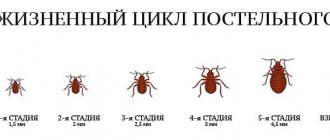When did ticks appear?
There is no exact answer to the question of when ticks appeared. It has been established that their giant ancestors are reptiles from the Akari group, which fed on the blood of dinosaurs. Gradually they began to reproduce and spread, forming many new species of arthropods.
Today, ticks have spread almost everywhere - they can be found in deciduous forests, river valleys, meadows and ravines. Thanks to the ability to quickly adapt to any, including the most negative environmental conditions, certain species of parasites live even in permafrost, parasitizing penguins.
Ticks are known for their wide habitat
Precautionary measures
Ixodids wait for their victims, sitting on grass stems and branches of bushes. They rarely rise more than a meter above the ground. There are no ways to identify an encephalitis tick right in the forest, so you need to take precautions using protective clothing.
When it hits a victim, the arthropod begins to move upward. This point is taken into account when gathering for the forest. Pants are tucked into socks, sweater into pants. The sleeves of a sweater or jacket are cuffed. At rest stops they conduct a thorough inspection of each other. Ticks that do not have time to bite remain on clothing, from where they can be easily collected.
When returning from a hike, all clothing is removed and the body is carefully examined. If an arachnid managed to get under clothes, then it can attach itself anywhere.
Important!
The tick bite is painless, although it causes a local allergic reaction.
It is possible to distinguish an encephalitis tick from an ordinary non-infectious one only after laboratory tests. Hence the recommendations: carefully remove the embedded bloodsucker and take it to the laboratory. It is especially important to comply with this condition in areas unfavorable for encephalitis.
The bite of an encephalitis tick is dangerous, even if the arthropod spent very little time on the victim. To become infected with viral encephalitis, it is enough that the parasite only pierces the skin and manages to inject its saliva into it.
Where did ticks come from in Russia?
Encephalitis tick is the popular name for the common ixodid tick, which is a carrier of the dangerous encephalitis virus. Ticks have existed in Russia since the Middle Ages, biting peasants and causing dangerous diseases. But at that time, these arthropods were not given much importance.
Massive attention to tick invasion began to be paid only in the late 30s of the last century, when these arthropods provoked an outbreak of epidemic among soldiers. The first cases of a dangerous disease were recorded in the Far East.
After medical research, it was found that the cause of the disease was the bites of ixodid taiga ticks, which caused the development of encephalitis. No less common were scabies parasites, which provoke the development of scabies - a disease that is very difficult to treat.
The answer to the question of where ticks came from in cities is the organization of household plots in the suburbs. In this way, arthropods managed to migrate to large cities and penetrate apartments.
Ticks are highly adaptable to various environmental conditions, including the most negative ones. Due to this, some species of arthropods prefer to live in forests and bushes, others have adapted to living in the steppes, and still others prefer various rooms and buildings.
Depending on the type of parasitism, all ticks are divided into burrowing and grazing. The former lay their eggs in the nests and burrows of animals and birds, the latter leave them on the surface of the ground.
Conspiracy theory of appearance
One of the main and most widespread theories of the appearance of ticks in Russia is conspiracy theory. Supporters of this version claim that until the 30s of the last century, these arthropods did not exist in the Soviet Union. They were brought from Asia.
According to conspiracy theories, in 1935, a secret laboratory was operating in China to create and test deadly biological weapons. After the invasion of the Soviet army, the laboratory's work stopped and all information was carefully destroyed, but something became known.
In a secret laboratory, new deadly viruses were created and studied, the carriers of which were rats, mosquitoes and other insects. They created mosquito encephalitis, which claimed several thousand lives in Japan. But this strain of the virus is radically different from tick-borne encephalitis.
What does an encephalitis tick look like?
Many people think that mites are a type of insect, but in fact, mites are a type of arachnid. As mentioned above, there is no separate species that can infect a person with such a dangerous disease, therefore there is no image of it. The tick is called "encephalitic" because it is potentially dangerous to humans. Based on this fact, other species can be considered dangerous. If the facts indicate otherwise, then the risk of contracting the virus is minimal.
Dog tick
This parasite can be found throughout the entire Eurasian continent, as well as in North America and North Africa, although in the last two parts of the world there is no encephalitis virus and this type of tick is not called encephalitis there. Unfortunately, in such conditions they are carriers of other diseases.
The dog tick is quite dangerous because it is a carrier of another serious disease for dogs - piroplasmosis. Therefore, dog owners are more interested in this fact. The size of the parasite can vary depending on how long ago the parasite consumed the blood of an animal or person. Even larvae and nymphs feed on blood, although they are quite small in size compared to adults. A hungry nymph is very small in size, about 1.5 mm, while an adult male is about 2.5 mm long. If the female is hungry, then its length is no more than 4 mm, but when she drinks blood, it can increase to 1 cm, or even more.
The body shape of a dog tick more closely resembles that of an egg, with a sharp point at the end. On the head of the parasite you can see something like a proboscis. On the back of the bloodsucker there is a protective shield of a dark brown hue. Males differ in that this shield covers the entire body. In females this shield is somewhat smaller. Typically, it only serves as protection for the front of the back. The abdomen of a hungry parasite is gray below and black above.
Interesting fact! When the bloodsucker is saturated with blood, it increases in size and begins to resemble a small gray bag, in front of which the legs of the parasite protrude.
Taiga tick
This is another dangerous representative of ixodid ticks that inhabits the middle and southern taiga. As a rule, the taiga is associated with Siberia, so this species also has a second name - the Siberian tick.
Habitat is limited to:
- In the west - Leningrad and Moscow regions.
- In the east - the Pacific Ocean.
- In the north – southern Karelia.
- In the south - Samara and Ulyanovsk regions.
Outside our country, the habitat of the taiga tick extends to the territory of Finland, the Baltic states, Belarus and northwestern Europe. Some numbers of ticks are found in Kamchatka and the Kuril Islands, as well as in the mountains of Central Asia.
It is important to know! In the forests of Crimea there is a parasite that is similar to the taiga tick, primarily in that it can penetrate 50% of its body into human skin. Therefore, it is possible that this is the same species.
As a rule, the term “encephalitis tick” refers to the taiga tick, which is associated with its significant habitat and the same significant danger to humans.
Interesting fact! The encephalitis tick is increasingly appearing within modern cities.
The appearance of the taiga tick differs little from its relative the dog tick, but the abdomen of a hungry taiga tick is red.
Already at the larval stage, ticks begin to feed on the blood, but not of large animals, most often rodents. At this stage of development, the larva is a translucent organism that is already parasitic and capable of transmitting a dangerous disease.
Important fact! If an adult tick is infected with encephalitis, then offspring are born that are also infected with a dangerous disease. It is impossible to determine the degree of danger of parasites by appearance, so you need to be afraid of both larvae, nymphs, and adults.
Encephalitis tick: habitats, symptoms and consequences of the bite, diagnosis and treatment Watch this video on YouTube
Habitats
In order to get rid of ticks, you need to know exactly where dangerous arthropods came from on your property or in your house. They live almost everywhere, preferring forest and park areas, especially with high humidity.
How to protect yourself from ticks?
The main habitats of encephalitis ticks:
- forest edges;
- glades;
- meadows;
- planting deciduous trees;
- thickets of bushes;
- shores of reservoirs.
The tick often appears in forests felled by windbreaks. But in coniferous forests without grass, it is almost impossible to find these arthropods, since their microclimate is not suitable for them. Parasites also avoid swampy soil and flooded areas.
Ticks appear only where any animals live, because they require blood for food. In urban environments, parasites wait for their victims in squares, park areas, on paths, paths and areas near multi-storey buildings.
Most often, the threat awaits in areas with abundant vegetation - especially where residential neighborhoods come into contact with dacha areas, forests, and cattle fields. In 90% of cases, ticks were transported to the city from rural areas or cottages.
In which regions of Russia are there no ticks?
Ticks have an extremely wide habitat. These arthropods can be found in forest and steppe areas, tall thickets of grass and shrubs, on the banks of rivers and lakes. But there are regions where ticks did not have time to reach. These include the territories of the mountainous Caucasus, Yamal, Kamchatka, Chukotka, Murmansk and Magadan regions. In these regions, not a single case of encephalitis tick bite has been reported.
There are regions of the Russian Federation in which not a single case of encephalitis tick bite has been registered.
Regions where different types of ticks live
In Russia, two types of ticks are most often found - European (dog) and taiga. They have different habitats:
- European – regions in the north-west of the country;
- taiga - Siberia, Far East, Ural.
The maximum number of infections with encephalitis ticks was recorded in Udmurtia, Siberia, Transbaikalia and Khakassia. These arthropods are no less active in the Sverdlovsk, Kemerovo, and Kurgan regions.
Ways of infection by ticks
Encephalitis ticks consume the blood of any animals or birds for their livelihoods. Often these ticks' food sources are infected with this virus. When a tick becomes saturated with the blood of an infected animal or bird, it immediately becomes a carrier of this infection. The second route of infection is transmission of the virus to future offspring.
As a rule, parasites only transmit the virus to their next victim, but do not suffer from this virus themselves.
Important fact! To find out whether a tick is infected with encephalitis, you need to submit it to a laboratory for analysis. For this reason, after a tick bite and its removal from the body, the parasite must be preserved and submitted for analysis as quickly as possible.
Routes of entry for different types of ticks
The routes through which ticks reach humans depend on the specific type of parasite. The most common types of arthropods include:
- Ixodidae - move to people from animal fur;
- argasaceae - live on the walls of premises, then move onto the body of chickens, and from there they get to people;
- armored - they carry helminth pathogens along with food;
- scabies - distributed along with personal hygiene items;
- linen - live in dusty corners, pieces of furniture, bed linen.
Common types of ticks also include grass ticks and brown ticks, which live in tall grass and on animals, from where they move to humans.
Measures to prevent tick-borne encephalitis
Vaccination is the only specific measure to prevent infection . Vaccinations against tick-borne encephalitis are indicated for persons who work in endemic areas permanently or travel there temporarily (business travelers, tourists, vacationers, gardeners and summer residents).
Vaccinations against tick-borne encephalitis are given in medical and preventive organizations, clinics, medical units, diagnostic centers, in first-aid posts of enterprises and educational institutions. Before visiting a potentially dangerous area, vaccination is carried out at least 1.5 months. This time is necessary to develop immunity to infection. If you were unable to get vaccinated against infection before the start of the season, you must follow a number of simple but very important rules when visiting potentially dangerous areas:
- give preference to light-colored clothing, as ticks will be more visible on it;
- clothing should be close to the body, with long sleeves and trousers, as well as with cuffs;
- tuck clothes into trousers;
- beware of tall grass and bushes, it is on them that parasites sit, do not walk along the edge of the path;
- be sure to wear a hat;
- treat clothes with repellent preparations;
- tuck trousers into high closed shoes.
Preventing tick bites
To avoid attacks by parasites, you need to follow simple recommendations when going to the forest and other possible tick habitats. Clothing should be light-colored, as it is easiest to see parasites on them. Long sleeves and a hood (or headdress) are required. You cannot wear shorts and expose parts of your body; pants must be tucked into socks. Shoes must also be closed.
Every 10-15 minutes you need to inspect your clothes. After the typical habitats of ticks have been abandoned, a thorough check for the presence of parasites on the body must be carried out. Shake your clothes outside, comb your hair thoroughly, inspect your neck, armpits, ears and groin area. It is these places that are most suitable for sucking bloodsuckers, because the skin there is thin and delicate.
Where do ticks come from in the house?
In order to get rid of a tick that has appeared in the house, you need to establish where exactly the parasite comes from. Their appearance in an apartment is not at all surprising, because these arthropods have an excellent ability to quickly and imperceptibly cling to clothing, a bag or shoes, thus getting into the apartment.
Arthropods can enter the home with pets. Ticks wait for their prey on tall grass, bushes, and secluded places with high humidity. From their hiding place they attack domestic animals, after which they get into the apartment on their fur.
Spider mites and bed mites are found in human homes. The first does not pose any danger to people and pets, affecting exclusively indoor plants. Bed parasites feed on blood. Most often they live in the following places:
| Habitat | Main clusters of ticks |
| Furniture items | Wooden bed frames, armchair and sofa upholstery |
| Places where dust accumulates | Carpets and rugs, mattresses, bed linen, books |
| Kitchen | Sink, trash can, cluttered cabinets |
| Household appliances, electronics | TVs, old DVD players |
Parasites choose secluded, remote places for themselves, where wet cleaning is very rarely carried out.
What types of ticks carry encephalitis?
Nature is not only a great place to relax and a source of inspiration. It is there that we face great danger in the form of small blood-sucking parasites. They can be found everywhere: in the grass and on the leaves.
Ixodid ticks (Ixodidae) are carriers of the causative agent of tick-borne encephalitis, a disease that mainly affects nerve cells in the human body. These may be brain structures, peripheral innervation, or radicular nerve endings in the spinal cord. Science knows about 650 species of these arachnids. In our latitudes, two species pose the greatest danger: taiga and dog.
The encephalitis tick is a carrier of a dangerous and currently incurable viral disease
Every year, about 2.5 thousand Russians become infected with the encephalitis virus.
Taiga tick
A small spider from 4 to 6 mm, belonging to the order Arthropods. Most often it can be found in the forests of Siberia, the Urals, and the Far East. Due to the fact that over the last century there has been a sharp warming of the climate, the usual habitat of the taiga tick has expanded. Today it can increasingly be found in Belarus, the Baltic countries and south-eastern France. Taiga ticks are carriers of Lyme disease and tick-borne encephalitis.
In Russia, the taiga tick is one of two species that transmit the encephalitis virus
Dog tick
This type of tick is widespread in the European part of Russia, as well as in the countries of Central and Northern Europe. At the end of spring and beginning of summer there is a peak in the number of their bites. The dog tick is similar to a taiga representative of the family, and by external signs it is almost impossible to distinguish them from each other. Today it is quite often found in summer cottages and garden plots, at camp sites, and in places where dogs are kept. A humid microclimate and the presence of a host are the main conditions for survival.
Dog ticks pose a danger not only to animals, but also to people.
Contrary to popular belief, ticks very rarely fall from trees. More often they live in grass, soil and fallen leaves.
Ticks are the main carriers of viral encephalitis. But you cannot judge by the appearance of a tick whether it is infected or not. This can only be detected in laboratory conditions. The source of the disease is both the bloodsucker itself and its larvae. The cause of tick infection can be considered to be its previous activity on a sick animal.
How do Ixodid ticks reproduce?
The female tick lays about 15 thousand eggs after drinking blood. But not everyone will reach the adult stage; this largely depends on natural conditions. The end result is usually only a few dozen individuals. The clutch matures within a few weeks.
Incredibly, ixodid ticks feed only 3-4 times during their entire life, which lasts several years: in the larval stage, in the nymph stage, and a couple of times as adults.
The larva feeds once. Small warm-blooded animals become her victims, since it is difficult for her to get to the top. The feeding process can last for 2–3 days, and then the larva becomes a nymph (an adult without sexual maturity). The individual spends the winter in this state. With the onset of spring, the nymph is ready to hunt, and larger animals become its victims. In this state, it matures to the imago stage (adult sexually mature individual) within a year. Unlike females, sexually mature males need from 30 minutes to several hours of preliminary saturation to be able to mate.
Ticks are able to sense the proximity of a person or animal at a distance of 5–10 m. It is for this reason that parasites are found in large quantities on paths and roads.
Video: one tick - two diseases
Useful tips
Tip #1
Ticks often enter an apartment or house with pets. In order to prevent the appearance of parasites, carefully examine your pet after each walk, parting the fur with your hands.
Tip #2
Do not be afraid of arthropods that live on the leaves and stems of indoor plants. Spider mites live only on indoor and garden plants and feed on their cell sap. These arthropods cause the death of plants, but do not pose any danger to people and domestic animals.
Tip #3
Pay special attention to any bites. The encephalitis tick is no different in appearance from a normal one, so it is impossible to visually identify a dangerous arthropod. This can only be done in laboratory conditions.
Where do ticks hide in winter?
In winter, ticks are inactive and hide in dry forest litter, in pastures, and in barns with livestock. When the earth begins to warm up with the spring sun, the parasites awaken from hibernation. With the appearance of the first thawed patches, they climb up and begin to look for their “owner”.
The tick makes its first attempts to attach itself at the end of March - beginning of April. Precautionary measures should be taken from now on. At the beginning of spring, night frosts inhibit tick activity. But with the advent of warmth, the parasites begin active hunting. The danger of an encephalitis tick bite remains until the end of the mating season and the female lays eggs. This is the end of spring and all summer.
The periods of tick activity depend on the climatic conditions in their habitats. In some areas they attack as soon as the air warms up to 3 degrees (for example, in Karelia). In others, their activity begins with the onset of 15-degree heat. In different zones of Russia, ticks are found from the beginning of April to the end of September. It happened that parasites were found on hunting dogs in October and even in November.
Tick protection
There are several different types of protection. It all depends on how often you are in places where they accumulate. If you rarely go out into nature, then simple repellents are enough. They are non-toxic and suitable for children and adults. But their service life is not so long, so you need to periodically spray more.
If you are a frequent visitor to the forest or pass a field on your way home, then you might want to think about getting vaccinated. You don’t have to constantly spend money on protective equipment, and it’s much calmer. If you do go into the forest without any means of protection, then wear closed clothing. First of all, take care of your head and neck. After returning home, be sure to inspect your clothes and yourself for ticks. To protect the animal, repellents are also suitable. But if the animal can go on a spree for several days, then the validity period will expire before they return. In this case, drops on the withers or collar will help.
If it does happen that this bloodsucker gets to you, the main thing is not to panic. Do not crush the tick, as this will allow the poison to enter the body faster. You can't treat the wound with anything! No oil, alcohol, kerosene or anything else. This all only makes the situation worse. You need to get to the nearest medical center, while carefully taking care of the bitten tick. He shouldn't get hurt.
If this is not possible, then you should get it yourself. Again: the tick must survive. Therefore, they use tweezers or something similar. Grasp it firmly, you need to carefully turn it clockwise. It is important not to separate the torso from the head. After this, put the tick in a jar and take it to a research laboratory, where it will be tested for the presence of viral diseases. Ticks are not so dangerous if you know how to deal with them. Try not to forget about this threat and buy protective equipment in a timely manner, and then you will not be afraid of them.
Symptoms and types of tick bites
The moment of ixodid tick suction often goes unnoticed because it is painless. After some time, the affected area swells, turns red, and itching and pain begin. Symptoms may persist for several days. The most attractive body parts for parasites, in descending order:
- Ears and area behind the ears;
- Neck, armpits;
- Lower back and abdomen;
- Groin.
The most characteristic appearance of an insect bite occurs when infected with Lyme disease: erythema in the form of a large spot up to 10-20 cm in diameter. Soon the edge of the spot becomes overgrown with a noticeable red outline, and its center turns white or blue. After a day, the erythema becomes crusty, and after 2 weeks, visible symptoms disappear. 1-2 hours after the parasite has been sucked in, the following sensations occur:
- Temperature increase;
- Weakness;
- Joint pain;
- Cardiopalmus;
- Itching;
- Enlarged lymph nodes, etc.
These signs are most pronounced in children and the elderly, those suffering from any diseases.
Where do ticks live: types and distribution
Representatives of the arachnid class are the oldest group of arthropods. They feel great in almost any environment: they climb into nests, burrows, and settle in plants.
The diet is based on plant debris, small arthropods, and soil fungi. Some species have become parasites. The most famous representative of the group is the ixodid tick. They transmit infection to humans.
On the territory of Russia there are 2 species of arthropods: taiga and European. Taiga ticks live in the Far East, Siberia, the Urals, and in the central European part. Ticks pose the greatest danger at the end of May-June. The European (aka canine) representative inhabits the North-West region. Ticks are most active from May to September.
The largest number of cases of infection were recorded in Siberia, Udmurtia, the Republic of Mari El, Khakassia, and Transbaikalia. Ticks are active in the Kurgan, Kemerovo, and Sverdlovsk regions.











